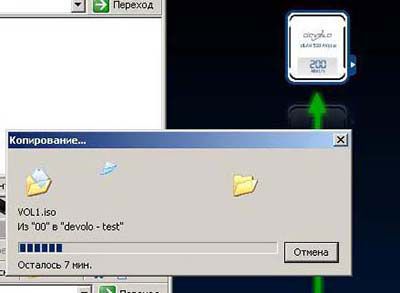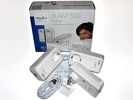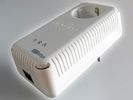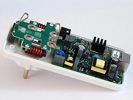Tests:
"Measuring" programs were not used to determine the transfer rate (it is not known what and how they measure), but an understandable and logical method was used: (file)/(folder with files) are copied and the copying time is measured. The size of (file)/(folder with files) is divided by the time and the transfer time is obtained. The measurements were carried out three times, the obtained results were averaged. 1 megabit = 1048576 bits = 131072 bytes in calculations..

A screenshot was used in support, on which the program from the delivery set ‘measured’ 200 Mbps, and the real rate made up 61.7 Mbps. (3 402 940 416 bytes / 131072 bytes / 421s)
Tests:
Test No.1
Connection through the Ethernet cable.
In order to check and exclude possible bottlenecks in the testing configuration,
tests trough the Ethernet cable were carried out (Pc-1 → patch-cord → Router → patch-cord → Pc-2).
Results of measurements:
1) 1 file (3.16GB) copying = 332.85 Mbps
2)Folder (692 files (2.93 GB) copying = 166.80 Mbps
It is known that the rate of copying a great number of files is lower than the same of one file,
but half as great was a wonder...
Test No.2
Connection of powerline adapters to extenders ("extension cords") - INCORRECT connection.
Results of measurements:
1) 1 file (3.16GB) copying = 44,30 Мбит/сек
2) Folder (692 files (2.93 GB) copying =39,18 Мбит/сек
Unexpectedly: the rate of copying one file and a folder with files is almost equal (difference was near 10%).
It was probable that the difference between the rates in the previous test was related to some limitations.
Test No.3
Connection of powerline adapters to sockets - CORRECT connection (almost correct).
Almost correct because we failed to get to a Pc-2 socket and therefore the adaptor was connected to an adjacent socket by 3m farther.
Results of measurements:
1) 1 file (3.16GB) copying =42,91 Мбит/сек
2) Folder (692 files (2.93 GB) copying =39,44 Мбит/сек
The copying rate did not change practically as compared with INCORRECT connection.
It turns out that one may not pay a special attention to the connection manual but to connect so as convenient.
Test No.4
Connection of powerline adapters to a single socket (adjacent jacks) - "IDEAL" connection.
Results of measurements:
1) 1 file (3.16GB) copying =56,56 Мбит/сек
2) Folder (692 files (2.93 GB) copying = 51,43 Мбит/сек
Here are real rates of a real "IDEAL" connection.
On the other hand, nobody expected "fairy-tale" 500 Mbps.
Test No.5
Television set.
In this case, we failed to find the means of measuring.
Therefore, an Ethernet cable, coming from the router, was unplugged from the television set
and replaced with a powerline adapter + a patch cord.
Nobody of the televiewers did not notice the substitution during a week.
The films from the computer disk were displayed smoothly, without any yanks and delays.
The productivity is sufficient for the device to be used with a media server or directly with a television set.
Test No.6
Connection through the Wi-Fi of the IEEE 802.11g standard (theoretical maximum rate 54 Mbps).
Results of measurements:
1. Following the copying start, the system notified us about the required time
for the completion of the process – it exceeded the values, recorded during previous tests, several times.
It was meaningless to waste so much time and the test was interrupted.
The copying rate in case of connection through the Wi-Fi of the IEEE 802.11g standard
is several times lower the same in case of connection through powerline adaptors.
Test No.7
Connection through the Wi-Fi of the IEEE 802.11n standard (theoretical maximum rate up to 600 Mbps).
Results of measurements:
1.The testing was not carried out because of compatible equipment absence.







